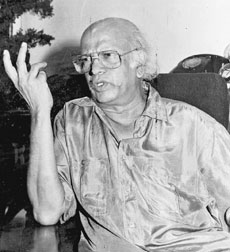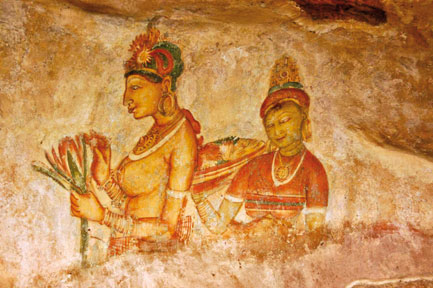Sunday Monologue
Siri Gunasinghe meets the Apsaras

|

Siri Gunasinghe |
Sri Lanka's cultural heritage includes an unparalleled array of
aesthetic monuments, within a restricted territorial space. Among these
are such religious edifices as Ruwanveli Maha Seya. Built long centuries
ago, these are still functional. Then there is the complex of irrigation
systems, which can challenge even the sophisticated technologies of our
own day. In the fields of arts, crafts and literature, the legacy we
have inherited is massive. We perhaps, are the only nation on earth that
has imparted a 'personality' even to a drop of water.
All these cumulative cultural refinements that evolved over the ages,
are exquisitely represented and synthesized by one particularly
impressive site and that is Sigiriya. The UN has duly recognized its
high significance as a symbol of man's cultural achievement. There have
been attempts to name it as one of the 7 wonders of the world.
Since, Sigiriya was re-discovered for the moderns, way back in the
late 1820s, many people from a variety of disciplines have focused upon
this site, making it the theme for their studies, surveys, monographs
and researches.
Sigiri Graffiti
|

Sigiri Apsaras |
Fairly recently, two valuable tomes, enriched the on-going discourse
on Sigiriya. One of these contributions is by the Speaker W.J.M.
Lokubandara. He titles his work as 'The Mystique of Sigiriya - Whispers
of the Mirror Wall.' He takes delight in the Sigiri Graffiti, as a
connoisseur of the poetic charm, enshrined in those delectable
compositions.
The other study is by Prof. Siri Gunasinghe who characterizes his
work by the intriguing title 'Sigiriya - Kassapa's Homage to Beauty'.
Both writers display vividly, their commitment and dedication to their
common theme Sigiriya each in his own peculiar mode and style.
Some people tend to believe, that the Speaker remains calm and
unruffled, when pandemonium breaks out all around him, perhaps by
contemplating the Apsaras and the graffiti of Sigiriya.
It is quite evident from the book, that its author, the speaker, has
a special niche in his deep inner recesses, carefully set aside for
Sigiriya poetry. He believes that, 'The mystique of Sigiriya lies in the
splendour of its poetry.'
It is quite essential that a detailed assessment of the Speaker's
volume should be effected for the serene joy and emotion of Sigiriya
lovers. My current focus is Siri Gunasinghe's scholarly look at Sigiriya
and its predominant features. He provides a forthright and self-assured
rationale for producing this sustained study. In his Preface, he has
this to offer, as an explanation for writing this book. "I found myself
thinking of the many untenable opinions advanced by scholars about
Sigiriya. I saw the need for an alternate approach to unravel Sigiriya's
secrets."
Mahavamsa story
The 'opinions' which Siri Gunasinghe causally dismisses as
'untenable', have accumulated for over one-and-a-half centuries. He does
not limit himself to those views expressed by sundry writers in
relatively modern times. He takes his quarrel directly to Mahawamsa and
its priestly author. In the paragraph which opens with the statement.
"The Mahawamsa story is not all that reliable," (page 4), he makes an
attempt to clear the name of Dhatusena retrospectively, implying that
chroniclers of our national annals, had set out to tarnish King
Dhatusena's image, seemingly with a marked deliberation.
In Siri Gunasinghe's view Dhatusena was a 'very civilized man', who
fell a pathetic victim to the stylus of the priestly author of Mahawamsa.
The pre-eminent quality of Siri Gunasinghe's tome, is its compelling
readability. Eschewing the dullness generally associated with learned
studies, Siri Gunasinghe synthesizes scholarly restraint with an
appealing polemical vehemence. This, I find is a highly viable formula
to ensure readers' participatory enjoyment of the work.
Siri Gunasinghe presents his thesis, in a quartet of segments, titled
1. Towards Sigiriya, 2. Building Sigiriya, 3. Paintings: The Enigma of
Beauties and 4. Ajantha's shadow on Sigiriya.
In the First Movement of the Quartet, Siri Gunasinghe establishes the
stature of Kassapa I (478- 496AD). With a clearly discernible tinge of
admiration, Siri Gunasinghe details out the Royal Plan for the Sigiriya
complex. To convert, solid rock, rising sheer out of the surrounding
verdant environment to a height of 200 meters, the Monarch must
certainly have had a crystal clear vision of what he wanted to do.
Pleasure palace
I consider it proper to state here, that it is in this work that one
gets a vivid and graphic description of the total Architectural Complex
at Sigiriya. Siri Gunasinghe, takes up the narration of Kassapa's
Palace-Concept, to establish how those various elements of the plan,
cohere into a holistic and integrated palatial structure. In Siri
Gunasinghe's view, the Sigiriya Complex was conceptualized as a pleasure
palace, built in a theme park, which highlighted the interplay between
water and verdure. The natural rocks and boulders were dramatized into a
man-made rock garden. The total landscape was interspersed with
pavilions for restful dalliance. The pervasive atmosphere of the whole
complex was decreed by a clearly perceptible hedonism. And, it is no
wonder therefore, that the pleasure bent monarch was anathema to the
austere monks of Mahavihara.
Siri Gunasinghe believes, that Kassapa, was wise enough to make
Sigiriya only his pleasure resort. He knew that if he spent all his days
at Sigiriya, the surfeit of pleasure would have cloyed.
Siri Gunasinghe's conjecture, goes counter to the stance taken up by
Mahawamsa.
Mahawamsa states that Kassapa betook to Sihigiriya, in fear of an
attack by his brother Moggallana and there is no reference of Kassapa
returning to Anuradhapura, during his 18-year reign.
But, the inescapable fact is, that, no other study dwells upon the
detail of Kassapa's Pleasure Palace, as Siri Gunasinghe does in this
work. Perhaps an exception could be technical records and professional
reports. In the early centuries of Buddhism in Sri Lanka, there could
very well have been monastic caves at this site. But, those provided
temporary shelter to meditating monks. "Monastery" is a misnomer in this
context. When Kassapa was enamoured of this site, those monastic caves,
must certainly have been a faded memory.
In the segment "Building Sigiriya: For what parpose?" Siri Gunasinghe
poses the question, to enable him to obtain space, to respond to his own
query.
The upshot of that segment is, Kassapa began building the Pleasure
Palace and its environs, even before he was, formally crowned King. Siri
Gunasinghe's basis for that kind of surmise is that, such a bewildering
complex as Sihigiri, is not at all possible within 18 years - which is
the duration of this reign. To build up his argument, Siri Gunasinghe
indicates that, while his father - King Dhatusena - ruled at
Anuradhapura, his son Kassapa would have been assigned the
administration of the Southern Region, where Sihigiri was located. The
author cites the tradition of royal sons being sent out as Provincial
Rulers.
Favourite position
Author Siri Gunasinghe, returns to his favourite position, that,
Kassapa was an aesthete par excellence. Waxing eloquent on his pet
theme, Siri Gunasinghe has this to say:
"That, he must have been struck by the sheer majesty of the enormous
solid rock that stood tall, surveying the endless green sweep stretching
as far as the eye can see, should be a given. No doubt he must have
visualized the beauty of nature he could contemplate from his palace in
the sky that, he would one day build on top of the rock."
Siri Gunasinghe's effort to counter the anti-Kassapa sentiments
Mahavamsa built up over the centuries, is quite impressive - to say the
least.
The goal of this exercise of advocacy seems to be to establish a
two-fold conclusion: Kassapa did not set out to build a rock fortress -
it was a Rock Palace of pleasure. He was an ultra-aesthete, given to the
upholding of beauty in its multi-faceted manifestations.
For all I know Siri Gunasinghe may experience a clear conscience, now
that he has done his best to dispel the negative aura Mahawamsa had
wrapped him in. This in effect, is a form of `cathartic research.'
To my mind, the area in this tome that should receive emphatic
attention is the material in the last two segments in the book. These
two segments are titled Paintings: "The Enigma of the Beauties" and "Ajanta's
Shadow on Sigiriya."
I must state with the fullest objectivity I can muster, that it is
Siri Gunasinghe who has made a praiseworthy research effort, to place
Sigiriya frescoes in their proper perspective in our indigenous
tradition of paintings - both folk and classic.
Siri Gunasinghe argues tersely to set aside the views of those, who
tend to propose that the frescoes at Sigiriya represent the hegemonist
influence of the Ajanta tradition.
When we observe the fluency of lines, the maturity of sketching, the
clearly evident effortlessness of the lining of figures in the frescoes
at Sigiriya, it is quite evident that Sigiriya Apsaras occupy a level,
far advanced from the position held by Ajantha figures.
Besides, the Frescoes at Sigiriya depict unmistakeable signs and
symbols that are specifically indigenous. A lady among those shown on
the sigiriya walls, holds elegantly between her thumb and fore-finger a
champak (sapu) flower, which is distinctly a local blossom.
In the portrayal of the female figure, there could be similarities
right across the cultural divides. But, the essential characteristics of
Sigiriya figures are entirely our own.
An aspect of Sigiriya paintings, that elicits massive popular
interest, is the subject matter of the frescoes. Who, in effect, are
these comely ladies?
In this instance Siri Gunasinghe seems to avoid scrupulously, opting
for any particular theme, associated with the ladies depicted by the
frescoes. In other words, he does not directly address the issue of the
identity of the Sigiriya ladies.
Negative attitude
He adopts a negative attitude. He rejects almost all the popularly
accepted views about the identity of the Sigiri Apsaras.
There are several well-known identifications of these ladies: They
are queens on their way to Pidurangala Vihara, apsaras floating on
clouds, noble women on their way to a ritual, divine maidens from Tusita
heaven, heavenly maids taking flowers for a ritual, lightning maidens
and cloud maidens, Queen of King Kassapa mourning the King's Death,
Queens on their way to aquatic sports, consorts of Bodhisatva
Avalokitesvara.
Siri Gunasinghe sets aside most of these views. The only positive
view, he expresses about the theme, is disarmingly simple. According to
him, 'These are only pictures of beautiful women and just that.' But,
although it may seem a wee bit unorthodox, I cannot help but introduce
my own view of the matter.
I feel, that most of these interpretations are far-fetched.
Many, of those who postulated their own interpretations, did not feel
the need to exploit one of the best sources available. This highly
effective source is the visitor to Sigiriya.
They expressed their views about the identity of the ladies in the
frescoes. The visitors were centuries close to the origin of the
frescoes. They would have been familiar with their identity. In most of
their writings, they addressed them in keenly erotic terms. These were
highly cultured people, who did not mar the purity of the mirror wall
with any unseemly expression.
If such a group thought it proper to resort to erotic poetry or
prose, certainly these ladies have nothing whatsoever to do with
religion. That sets aside interpretations that have a religious feel to
them.
These ladies scatter flowers and assume dance poses. One lady
displays her hands in a dance stance. Her costumes are agitated as would
happen if she danced.
Given such a situation, this is quite clearly a group of ladies,
dancing and scattering flowers. In consequence, they are not on their
way to a monastery. Nor are they queens. They would indulge in those
activities.
In this background, I personally feel that we should stop various
fanciful somersaults of the imagination and should stand firmly on
ground reality.
Aesthetic beauty
Siri Gunasinghe has done just that, when he said they are just a bevy
of beautiful ladies, providing a scene of aesthetic beauty.
But, to be totally, realistic, we must appreciate that they are
beautiful ladies, but they have been painted here, for a practical and
pragmatic function. They are there to greet the visitors, with dances
and the scattering of flowers.'
I am quite certain that this is the right interpretation. I say this,
because at several sites in Sri Lanka, this kind of group is depicted,
performing this greeting function. Painting on the Kotiyagala Cave
Ceiling is an instance.
In comparison with the sophistication of Sigiriya though, Kotiyagala
is fairly folk in urge. However, I do not consider this exactly the
right forum for the substantiation of my position in this matter.
This book, by Siri Gunasinghe, is meticularly researched, elegantly
written, expository in style and is an instance of an exceptionally high
research effort.
The publishers of this tome is Vijitha Yapa Publications, deserve the
gratitude of the public, for presenting this book to the world.
Incidentally some of the illustrative material, that adorns this work
is derived from the photographs taken by Vijitha Yapa and Mrs. Lalana
Yapa. Meanwhile, in spite of Siri Gunasinghe, Sigiriya Apsaras are still
a global enigma.
|

